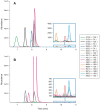Dog poisonings associated with a Microcystis aeruginosa bloom in the Netherlands
- PMID: 23493170
- PMCID: PMC3705278
- DOI: 10.3390/toxins5030556
Dog poisonings associated with a Microcystis aeruginosa bloom in the Netherlands
Abstract
In early autumn 2011, three dogs died after they had been exposed to a Microcystis aeruginosa bloom on Lake Amstelmeer, The Netherlands. The cyanobacterial scum from the lake contained up to 5.27 × 103 μg g(-1) dry-weight microcystin, the vomit of one of the dogs contained on average 94 µg microcystin g(-1) dry-weight. In both cases, microcystin-LR was the most abundant variant. This is the first report of dog deaths associated with a Microcystis bloom and microcystin poisoning in The Netherlands.
Figures


References
Publication types
MeSH terms
Substances
LinkOut - more resources
Full Text Sources
Other Literature Sources

